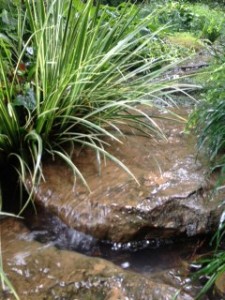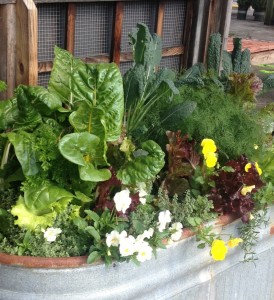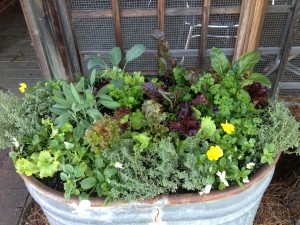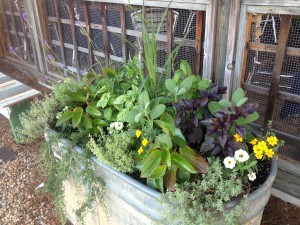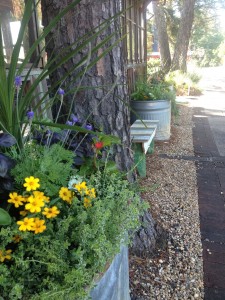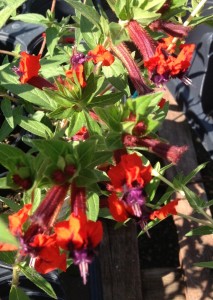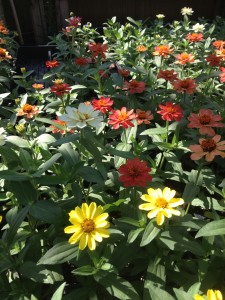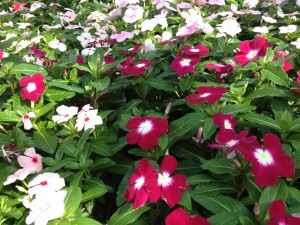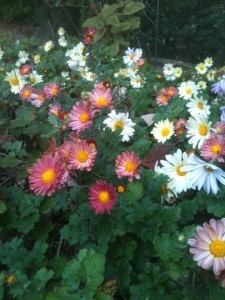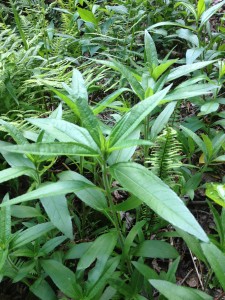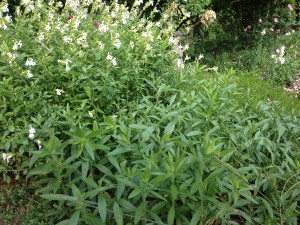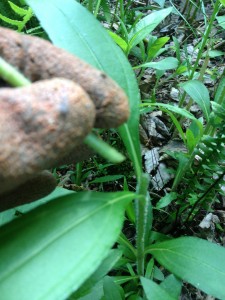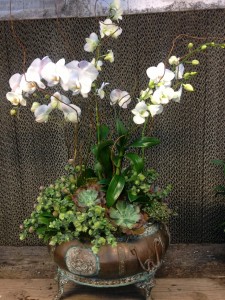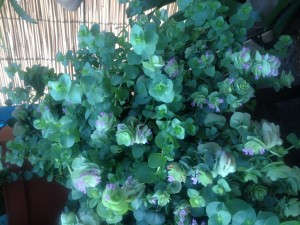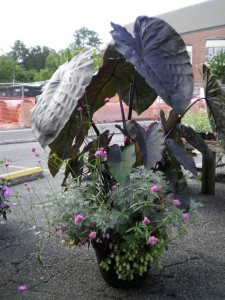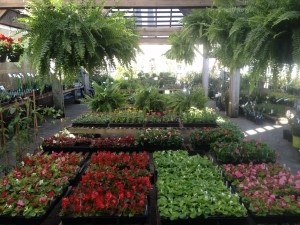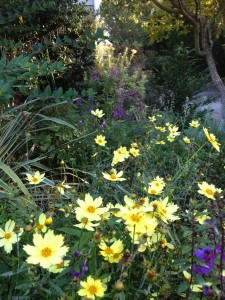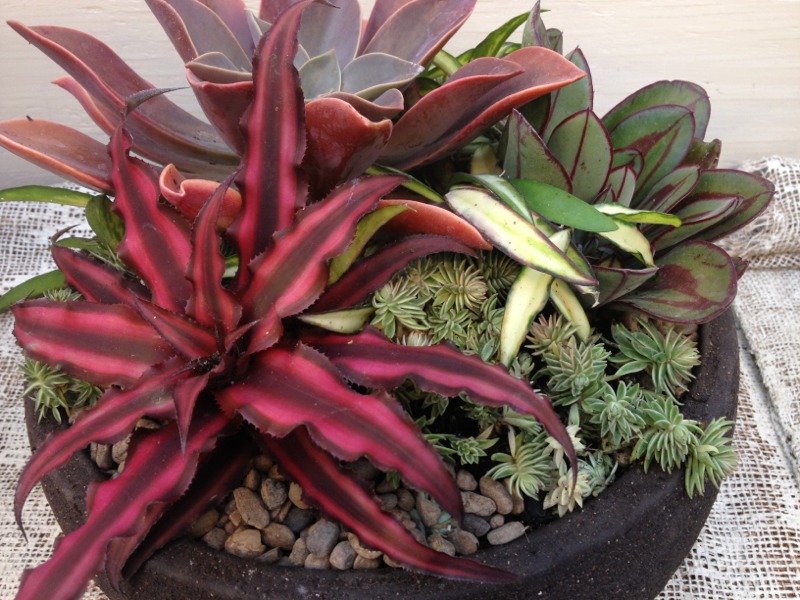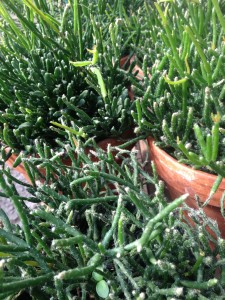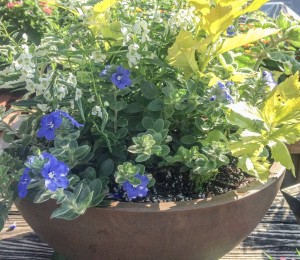 The other day I noticed we only had two midsize, light-weight brown planter bowls left in stock, and they were just calling to be planted. Since summer is relatively slow and we have time on our hands, we’ve been planting all sorts of mixed containers with annuals, herbs, perennials, and everything in between to tempt folks coming in; and I thought one of these might be just the right size for someone.
The other day I noticed we only had two midsize, light-weight brown planter bowls left in stock, and they were just calling to be planted. Since summer is relatively slow and we have time on our hands, we’ve been planting all sorts of mixed containers with annuals, herbs, perennials, and everything in between to tempt folks coming in; and I thought one of these might be just the right size for someone.
Usually if I plant two of something for display, I make them similar, but, with these, I decided to play off the brown color of the bowls with two different plantings – both for sun, but each quite different, using annuals. Here’s what I came up with. Of course, there are endless variations of plants out there; these are simply my two versions using annuals available mid-summer.
The first planting uses light colors that are quite harmonious – white, blue and yellow. A variegated Swedish ivy and yellow duranta are the all-important foliage accents here, and the white flowers of the angelonia will add a spiky bloom in the center (The yellow duranta will need some clipping eventually to keep it at the right proportion for this planting.). Pretty blooms of a blue daze trailing over the edge complete the picture. If the container were larger, I might have added a silver thyme as well.
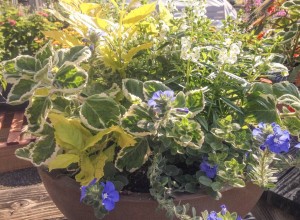
Color is an interesting thing. You can either go big, bold, and wild and mix many together, or you might choose two or three very opposite colors (Think purple and orange, for example.). Combinations can also be fairly calm, using colors closely related.
Flowers obviously add color to any composition, but don’t forget the importance of foliage too. Many times I’ll begin a design by pulling foliage plants to accent a particular planter, then add blooming plants to play off of those leaves. In fact, leaves and their shapes are extremely important to the overall look of a planter once it’s completed and growing out.
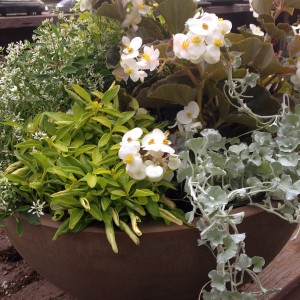
The second is quite different, though once again there’s a yellow foliage (Yellow works so well with brown!), this time a dwarf Joseph’s coat, and white blooms too, represented here by a dark leaved baby wing begonia. Its leaves match the color of the bowl almost perfectly. The begonia is a heavy presence in this planting; so, to lighten it up, an airy blooming white euphorbia went in next. Finally, the silvery foliage of a trailing dichondra spills over the edge, adding a nice contrast to the brown of the pot.
So, there are now two fairly simple, yet quite dissimilar plantings in the same bowl. At another time of the year, the choices would have been even more different…yet another reason container gardening is so entertaining!
Stop in and take a look at our container planting designs if you’re in the Birmingham area. We try to have as many made up as possible to give you ideas and inspiration!


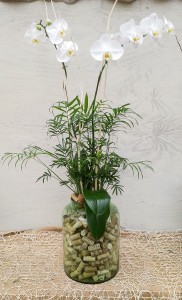
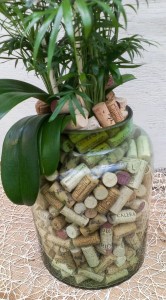
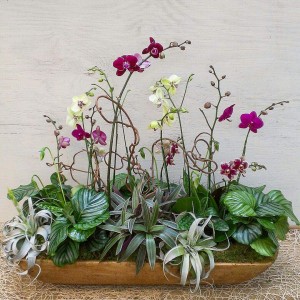
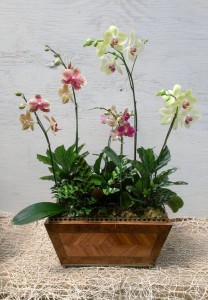

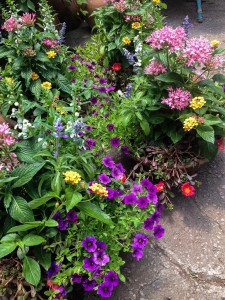
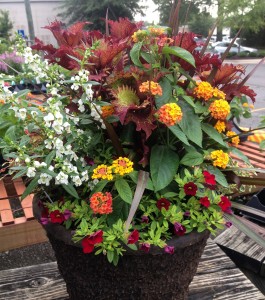 Many of the container plantings we do are in light, mâché pots that can either be used on their own or placed in another planter. Here’s one with a mix of sun coleus, a dracaena (Barely visible in this picture, it adds a spiky leaf.), lantana, red million bells to trail, and a white angelonia. This planting will get much larger and fuller as the heat of summer settles in, and daily watering will be necessary.
Many of the container plantings we do are in light, mâché pots that can either be used on their own or placed in another planter. Here’s one with a mix of sun coleus, a dracaena (Barely visible in this picture, it adds a spiky leaf.), lantana, red million bells to trail, and a white angelonia. This planting will get much larger and fuller as the heat of summer settles in, and daily watering will be necessary.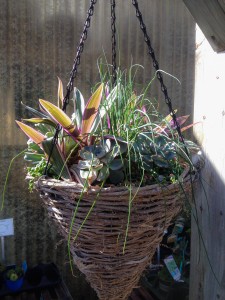 The white, cone-shaped hanging basket shown here is now home to a common houseplant, an herb, and some succulents. While it may seem an unusual combination, it’s working quite nicely and has a cool, summery look. The houseplant is a pink and green tradescantia (It’s also known as Rhoeo spathacea.), sometimes called Moses In The Cradle.
The white, cone-shaped hanging basket shown here is now home to a common houseplant, an herb, and some succulents. While it may seem an unusual combination, it’s working quite nicely and has a cool, summery look. The houseplant is a pink and green tradescantia (It’s also known as Rhoeo spathacea.), sometimes called Moses In The Cradle.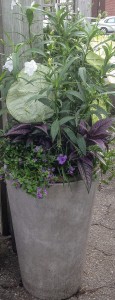 We have a few tall, lightweight planters still available, and this planting shows one of them off. A tall, white ruellia (They’re sometimes called perennial petunia.) is combined here with a caladium whose leaves will get very large. The name of this one is ‘Garden White’, and it’s impressive! The large leaves will contrast nicely with the smaller leaves of the ruellia. Another foliage contrast is provided by the silvery-purple leaves of a strobilanthes, sometimes called Persian Shield. A beautiful foliage plant, it benefits from a cutback every now and then if it gets to lanky in the planting. To trail there’s a blue fanflower, scaevola.
We have a few tall, lightweight planters still available, and this planting shows one of them off. A tall, white ruellia (They’re sometimes called perennial petunia.) is combined here with a caladium whose leaves will get very large. The name of this one is ‘Garden White’, and it’s impressive! The large leaves will contrast nicely with the smaller leaves of the ruellia. Another foliage contrast is provided by the silvery-purple leaves of a strobilanthes, sometimes called Persian Shield. A beautiful foliage plant, it benefits from a cutback every now and then if it gets to lanky in the planting. To trail there’s a blue fanflower, scaevola. Finally, since we had a few ‘Carolina Sapphire’ cypress left, they were candidates for a planting using smaller plants at the base to add fullness, color, and trail. These planters will be in the sun and can be changed out in the fall with the addition of pansies and other cold weather plants for the winter season.
Finally, since we had a few ‘Carolina Sapphire’ cypress left, they were candidates for a planting using smaller plants at the base to add fullness, color, and trail. These planters will be in the sun and can be changed out in the fall with the addition of pansies and other cold weather plants for the winter season.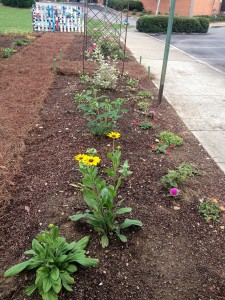
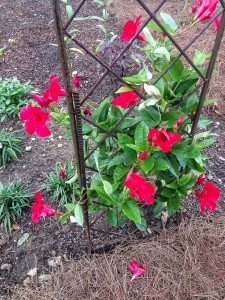
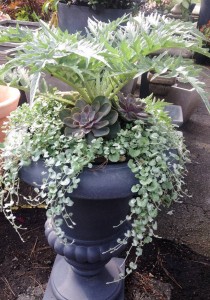
 The next uses a red fountain grass for height in a tall planter with the addition of white Profusion zinnias and white euphorbia as fillers. Spilling out are blue daze and potato vine. This planting will bloom continuously with regular water and periodic deadheading or clipping back of the zinnias. Late in the summer the grass will begin to bloom for an end of the season finale.
The next uses a red fountain grass for height in a tall planter with the addition of white Profusion zinnias and white euphorbia as fillers. Spilling out are blue daze and potato vine. This planting will bloom continuously with regular water and periodic deadheading or clipping back of the zinnias. Late in the summer the grass will begin to bloom for an end of the season finale.
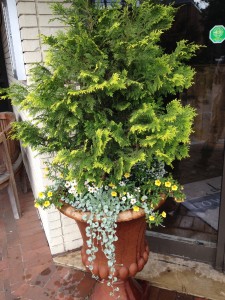 Many of you have pots that have shrubs in them that live year round, and just need some color added each season. In this example, the Chamaecyparis adds yellow foliage and is complimented through the summer with yellow million bells, white narrow leaf zinnias, silver dichondra and some euphorbia. The million bells and zinnias will be cut back when they get too leggy (There’s no need to deadhead each individual bloom on these.) and it will be watered daily, since the Chamaecyparis has been in this planter for a few years and it’s roots are filling the planter quite extensively.
Many of you have pots that have shrubs in them that live year round, and just need some color added each season. In this example, the Chamaecyparis adds yellow foliage and is complimented through the summer with yellow million bells, white narrow leaf zinnias, silver dichondra and some euphorbia. The million bells and zinnias will be cut back when they get too leggy (There’s no need to deadhead each individual bloom on these.) and it will be watered daily, since the Chamaecyparis has been in this planter for a few years and it’s roots are filling the planter quite extensively.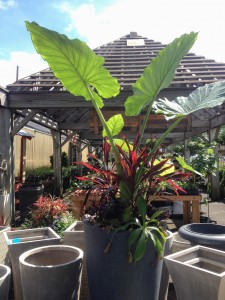 The final planting uses a dramatic, and very large Alocasia – this speaks for itself, though it has supporting players as well, including dracaena, epescia, nepenthes, and alternanthera. It’s quite a combo.
The final planting uses a dramatic, and very large Alocasia – this speaks for itself, though it has supporting players as well, including dracaena, epescia, nepenthes, and alternanthera. It’s quite a combo.

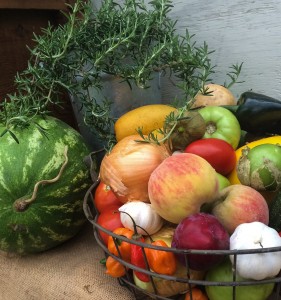

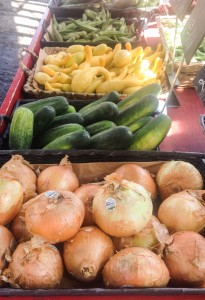
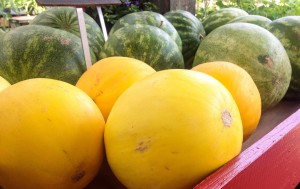

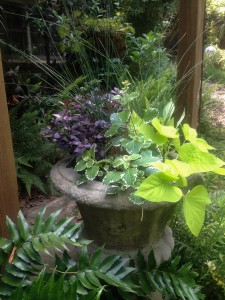
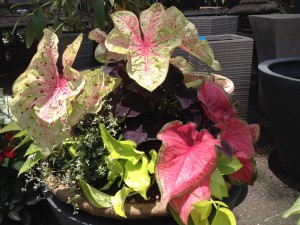
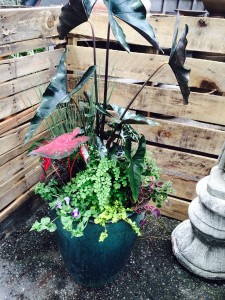 Sometimes it’s fun to try a plant that’s more unusual as the centerpiece of a design. In this glazed pot the dark leaf of the Alocasia is a beautiful contrast to the coleus, grasslike juncus, maidenhair fern, trailing torenia, and creeping jenny.
Sometimes it’s fun to try a plant that’s more unusual as the centerpiece of a design. In this glazed pot the dark leaf of the Alocasia is a beautiful contrast to the coleus, grasslike juncus, maidenhair fern, trailing torenia, and creeping jenny.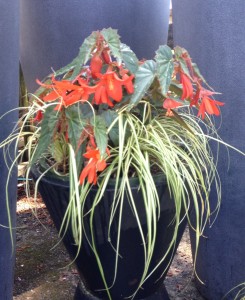 Finally, here’s a simple planting for shade using a begonia and the contrasting leaf and brightness of carex ‘Evergold’, which will spill over the edge of the container. Simple, yet effective. The begonia will continue to bloom with a couple of cutbacks if it gets “leggy.”
Finally, here’s a simple planting for shade using a begonia and the contrasting leaf and brightness of carex ‘Evergold’, which will spill over the edge of the container. Simple, yet effective. The begonia will continue to bloom with a couple of cutbacks if it gets “leggy.”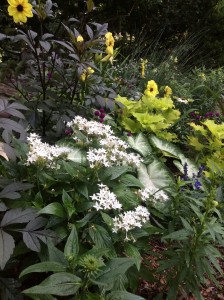
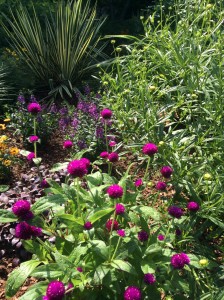
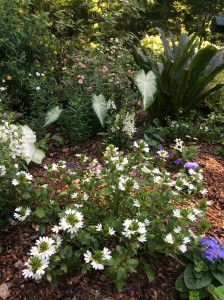
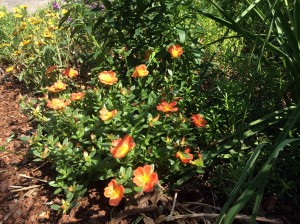
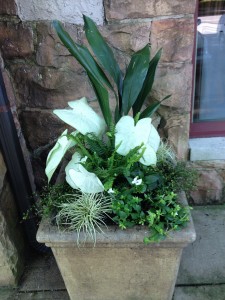 A testament to its common name of cast iron plant, the aspidistra looked amazingly good considering the bone-chilling temperatures Birmingham dipped to in January. It only needed a few leaves cut out, and no thinning was required this season…probably due to the cold. A heuchera, that had been added in the
A testament to its common name of cast iron plant, the aspidistra looked amazingly good considering the bone-chilling temperatures Birmingham dipped to in January. It only needed a few leaves cut out, and no thinning was required this season…probably due to the cold. A heuchera, that had been added in the  Torenia is an interesting plant, useful in
Torenia is an interesting plant, useful in 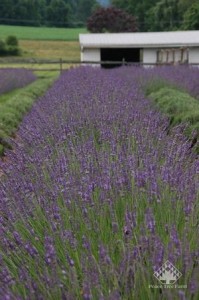
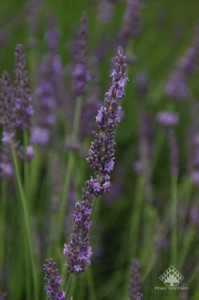
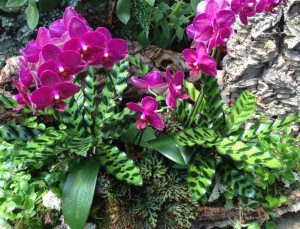 This summer’s wet, cool weather might have kept many of you out of your gardens, but we’ve managed to stay busy in the greenhouse putting together arrangements filled with orchids, succulents, houseplants, and so much more…here’s a peek at some of them. We regularly have folks who stop in just to see what we’ve been working on! All of these arrangements are composed of live plants, no cut flowers here.
This summer’s wet, cool weather might have kept many of you out of your gardens, but we’ve managed to stay busy in the greenhouse putting together arrangements filled with orchids, succulents, houseplants, and so much more…here’s a peek at some of them. We regularly have folks who stop in just to see what we’ve been working on! All of these arrangements are composed of live plants, no cut flowers here.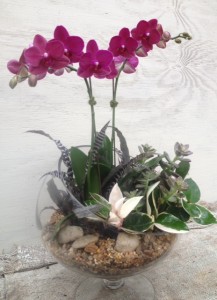
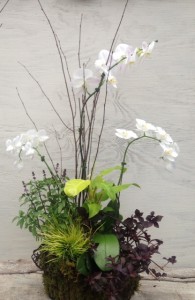
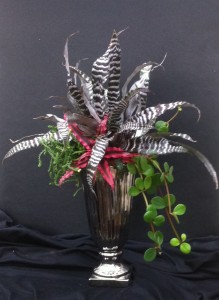 Finally, the silver container was given in memory of someone…the longlasting and low maintenance houseplants of trailiing pepperomia and cryptanthus make excellent companions. It’s gratifying, also, to know that whoever is on the receiving end will be able to enjoy this longer than a fresh flower arrangement could ever hope to last.
Finally, the silver container was given in memory of someone…the longlasting and low maintenance houseplants of trailiing pepperomia and cryptanthus make excellent companions. It’s gratifying, also, to know that whoever is on the receiving end will be able to enjoy this longer than a fresh flower arrangement could ever hope to last.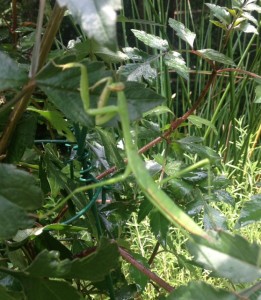 This post is all about relaxing in your garden. Yes, I said relaxing…it’s late summer and the garden is buzzing with life – or should be. Hopefully we’ve helped you create the perfect habitat for beneficial and beautiful insects and other critters. Take a stroll every so often and really see all that’s happening in their home.
This post is all about relaxing in your garden. Yes, I said relaxing…it’s late summer and the garden is buzzing with life – or should be. Hopefully we’ve helped you create the perfect habitat for beneficial and beautiful insects and other critters. Take a stroll every so often and really see all that’s happening in their home.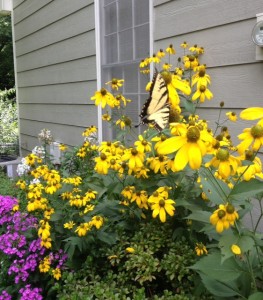
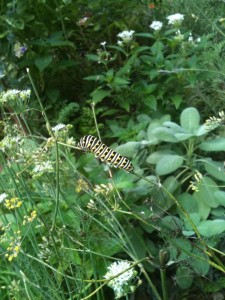 I’ve also seen a few swallowtail butterflies – graceful beacons of midsummer, moving from pentas to zinnia to dahlia and back -.and one that had somehow torn its wing and that I found the next day in tatters in one of my beds. The circle of life continues…
I’ve also seen a few swallowtail butterflies – graceful beacons of midsummer, moving from pentas to zinnia to dahlia and back -.and one that had somehow torn its wing and that I found the next day in tatters in one of my beds. The circle of life continues…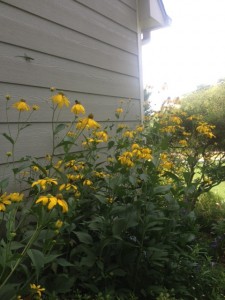
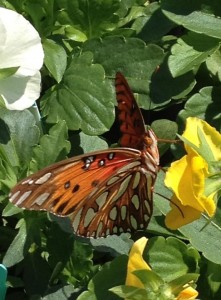
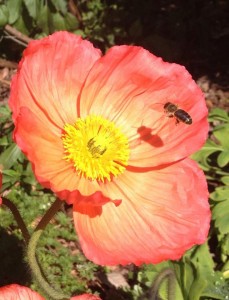 I somehow captured the most perfect shot of a honeybee going in for a landing on a poppy this past spring. We need to be mindful of the bees…I’m thankful when I see them happily moving from one bloom to another on the vitex in June or the salvias in August.
I somehow captured the most perfect shot of a honeybee going in for a landing on a poppy this past spring. We need to be mindful of the bees…I’m thankful when I see them happily moving from one bloom to another on the vitex in June or the salvias in August.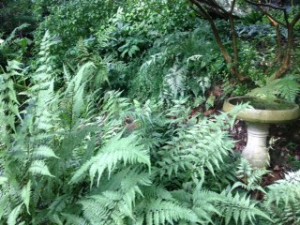 With 2013 beginning with a wet, cool spring and the rain continuing into early summer, it seemed like we’d been transported into a different universe than Alabama, didn’t it? All the rain may have caused some complacency – everything seems so much lusher than it usually is this time of year…now the heat is here, though, and it seems certain we’ll be entering our usual summer pattern of hit and miss rain showers with lots of warmth and humidity…
With 2013 beginning with a wet, cool spring and the rain continuing into early summer, it seemed like we’d been transported into a different universe than Alabama, didn’t it? All the rain may have caused some complacency – everything seems so much lusher than it usually is this time of year…now the heat is here, though, and it seems certain we’ll be entering our usual summer pattern of hit and miss rain showers with lots of warmth and humidity… Established plantings in your landscape should be doing well, but be aware that new plantings of shrubs, trees and perennials will need supplemental watering this first summer – pay attention to them. The requirement for new plantings is an inch of water each week.
Established plantings in your landscape should be doing well, but be aware that new plantings of shrubs, trees and perennials will need supplemental watering this first summer – pay attention to them. The requirement for new plantings is an inch of water each week.